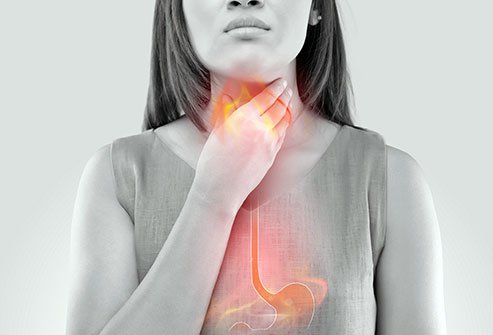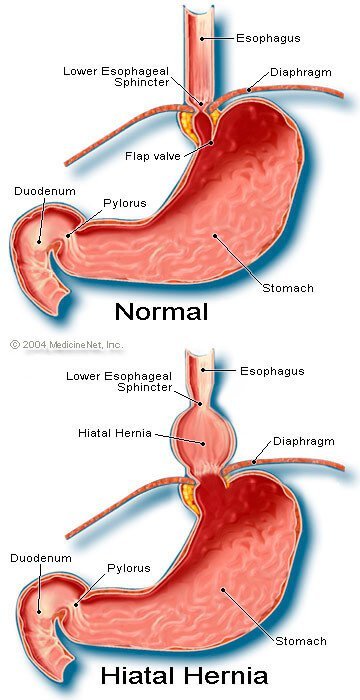Hiatal Hernia
What is a hiatal hernia (definition)?

The esophagus connects the throat to the stomach. It passes through the chest and enters the abdomen through a hole in the diaphragm called the esophageal hiatus. The term hiatal hernia describes a condition where the upper part of the stomach that normally is located just below the diaphragm in the abdomen pushes or protrudes through the esophageal hiatus to rest within the chest cavity.
What does a hiatal hernia feel like (symptoms and signs)?
Hiatal hernias do not cause symptoms, and most are found incidentally when a person has a chest X-ray or abdominal X-rays, including;
- An upper GI series and CT scans in which the patient swallows barium or another contrast material.
- It also is found incidentally during gastrointestinal endoscopy of the esophagus, stomach and duodenum (EGD).
- If symptoms do occur, they are due to gastroesophageal reflux disease (GERD) where the digestive juice containing acid from the stomach moves up into the esophagus.
Unfortunately, the esophagus does not have a similar protective lining. Instead, it relies on the lower esophageal sphincter (LES), a band of muscle located at the junction of the stomach and esophagus, and the muscle of the diaphragm surrounding the esophagus to act as a valve to prevent acid from refluxing from the stomach into the esophagus.
Moreover, to the esophageal sphincter (LES), the normal location of the stomach and esophageal junction within the abdominal cavity is important in keeping acid where it belongs. There is increased pressure within the abdominal cavity compared to the chest cavity, particularly during inspiration which would normally cause the acid and contents from the stomach to reflux back into the esophagus, but the combination of pressure exerted within the lower mostly is from the esophageal sphincter (LES), and the muscle of the diaphragm create a zone of higher pressure that keeps stomach acid in the stomach.
In the situation of a sliding hiatal hernia, the gasatroesophageal and esophagus junction moves above the diaphragm and into the chest, and the portion of the higher-pressure zone due to the diaphragm is lost. Acid is allowed to reflux back into the esophagus causing inflammation of the lining of the esophagus.
The symptoms of gastroesophageal reflux disease (GERD) include
- heartburn,
- chest pain or burning,
- nausea,
- vomiting or retching (dry heaves)
- burping
- waterbrash, the rapid appearance of a large amount of saliva in the mouth that is stimulated by the refluxing acid
What makes symptoms of a hiatal hernia more painful and worse?
- Symptoms of a hiatal hernia usually are worse after meals, and may be made worse when lying flat, which may resolve with sitting up or walking.
- In some people with a hiatal hernia, it refluxes into the lower esophagus that sets off nervous reflexes that can cause a cough or even spasm of the small airways within the lungs people.
- Rarely, some people with a hiatal hernia, it may reflux acid droplets into the back of their throat. This acid can be inhaled or aspirated into the lung causing
- coughing spasms,
- asthma, or
- repeated lung infections including pneumonia and bronchitis.
People of any age can get a hiatal hernia from infants to the elderly. Fortunately, it is very rare.
What is a paraesophageal hiatal hernia? What are its symptoms and signs?
Usually, people with a paraesophageal sphincter have no symptoms of reflux because the gastroeophageal esophagus junction remains below the diaphragm, but if the hernia is large, the way the stomach rotates into the chest, there is the possibility of volvulus of the stomach in which the stomach twists upon itself. Fortunately, paraesophageal hernias are relatively uncommon.
Rarely, gastric volvulus of the stomach in which an abnormal rotation of the stomach more than 180 degrees is a surgical emergency and causes difficulty with
- painful swallowing,
- chest pain, and
- vomiting.
What causes a hiatal hernia? What does it look like (pictures)?

Normally, the space where the esophagus passes through the diaphragm is sealed by the phrenoesophageal membrane (a thin membrane of tissue connecting the esophagus with the diaphragm). Thus, the chest cavity and abdominal cavity are separated from each other. Because the muscles of the esophagus tighten and the esophagus shortens with each swallow, essentially squeezing food into the stomach, this membrane needs to be elastic to allow the esophagus to move up and down.
Normal physiology allows the gastroesophageal junction, where the esophagus and stomach meet, to move back and forth within the hiatus. However, at rest the gastroesophageal junction should be located below the diaphragm and in the abdominal cavity. It is important to remember that these distances are very short.
Over time, the phrenoesophageal membrane may weaken, and a part of the stomach may herniate through the membrane. It may remain above the diaphragm permanently or move back and forth across the diaphragm.
Hiatal hernias are common, and in the majority of cases the cause is unknown. They may be present at birth or develop later in life.
- Pregnancy: Theoretically, decreased abdominal muscle tone and increased pressure within the abdominal cavity could lead to the development of a hiatal hernia. Thus, people who are obese and women who are pregnant may be at an increased risk for developing a hiatal hernia although this has not been demonstrated.
- Constipation and vomiting: People who have repetitive vomiting or those who have constipation and strain to have a bowel movement, increase the intra-abdominal pressure when they strain, and this may weaken the phrenoesophageal membrane.
- The membrane also may weaken and lose its elasticity as a part of aging.
- Ascites: Ascites is an abnormal collection of fluid in the abdominal cavity, which is often seen in people with liver failure, also may be associated with the development of a hiatal hernia.
What are the types of hiatal hernias?
There are three types of hiatal hernias.
- Sling hiatal hernia: A sliding hiatal hernia is the most common type of hiatal hernia is a sliding hiatal hernia.
- A sliding hiatal hernia accounts for 95% of all hiatal hernias.
- In a sliding hernia, a portion of the stomach slides upward through the diaphragm and into the chest such that the junction of the esophagus and stomach (gastro- esophageal junction) lies in the chest.
- A sliding hernia is present during inspiration when the diaphragm contracts and descends toward the abdominal cavity and when the esophagus shortens during swallowing, but at rest it is not present.
- Paraesophageal hernia: A paraesophageal hernia accounts for only 5% of hiatal hernias, the gap in the the diaphragm through which the hernia occurs, phrenoesophageal membrane is larger, and a portion of the stomach herniates into the chest alongside the esophagus and stays there, but the junction between the stomach and the esophagus remains below the diaphragm.
- Paraesophageal and sliding: In a combination of events, should the defect in the diaphragm become larger, the junction between the stomach and the esophagus can herniate through the diaphragm into the chest causing a hernia that is both paraesophageal and sliding.
What procedures and tests diagnose hiatal hernias?
- X-rays, EDG, and CT scan: Most often, a hiatal hernia is found incidentally with gastrointestinal X-rays, EGD, and sometimes CT scan, since by itself, it causes no symptoms. Only when there are associated symptoms of GERD will that usually need treatment. With symptoms of GERD, it is likely that a hiatal hernia is present since most people with GERD have hiatal hernias.
- Barium swallow or upper GI series: Often, the diagnosis of a hiatal hernia is confirmed by a barium swallow or upper GI series, where a radiologist uses fluoroscopy to observe in real time as the swallowed barium outlines the esophagus, stomach and upper part of the small intestine. In addition to seeing the anatomy, the radiologist also can comment upon the movement of the muscles that work to propel the barium (and presumably) food through the esophagus into the stomach and beyond.
- Endoscopy: Endoscopy is a procedure performed under sedation by a gastroenterologist to look at the lining of the esophagus, stomach, and duodenum. A hiatal hernia may be diagnosed easily in this manner and more importantly, the physician may be able to see complications of GERD from the reflux of acid. Endoscopy is used to diagnose scarring with strictures (narrowing of the esophagus) and precancerous conditions like Barrett's esophagus. Biopsies or small tissue samples may be taken and examined under a microscope.
What is the treatment for hiatal hernias?
The treatment for hiatal hernia is really treatment for GERD and minimizing acid reflux. This includes
- decreasing acid secretion in the stomach,
- avoiding substances that are irritating to the stomach lining, and
- mechanical means to keep the remaining acid in the stomach where it belongs.
What medications treat hiatal hernias?
Proton pump inhibitor (PPIs) medications are commonly used to decrease acid production, which include
- omeprazole (Prilosec),
- lansoprazole (Prevacid),
- pantoprazole (Protonix),
- rabeprazole (Aciphex) and
- esomeprazole (Nexium).
When is surgery for a hiatal hernia necessary?
Most often, the surgery is done as a minimally invasive procedure using a laparoscope. While there are different techniques, the results are similar and the best option is usually the one the surgeon feels most comfortable performing in a specific situation.
Proton pump inhibitor medications: With the development of proton pump inhibitor medications, medical therapy has decreased the necessity of surgery for sliding hiatal hernias, and it is often only recommended for people who have failed aggressive drug treatment or who have developed complications of GERD include
- strictures,
- ulcers, and
- bleeding or those with repeated pneumonia form aspiration.
Paraesophageal hernias: People with paraesophageal hernias often have no symptoms, and surgery is required only if the hernias become trapped in the chest and become stuck in the diaphragmatic hiatus or rotate to cause a volvulus. While this is more commonly seen in older people, paraesophageal hernias also may occur from birth as a congenital condition in neonates and infants.
What diet changes help avoid hiatal hernia pain, symptoms, and triggers?
Foods, drinks, and home changes that treat hiatal hernia symptoms include:
- Elevating the head of the bed when sleeping to allow gravity to prevent acid from refluxing into the esophagus.
- Eating small frequent meals may help instead of eating two or three larger meals a day.
- Some foods that that trigger hiatal symptoms should be avoided, and include
- spicy,
- greasy foods,
- onions,
- tomatoes, and
- citrus fruits,
However, most people are generally aware of the foods that trigger heartburn symptoms and avoid them.
What are the complications of a hiatal hernia? Is it serious?
If treated, a hiatal hernia is appropriately and lifestyle changes are made, you can minimize the effects of a hiatal hernia. If left untreated, complications can cause a strangulated hiatal hernia, which symptoms include
- They won't go away
- Are severe
- You are not clear what is causing your symptoms
Signs and symptoms of a hiatal hernia that needs to be treated right away, include
- Vomiting blood
- Dark, tarry stools
- Palpitations (feel heart beating in your chest) or feeling faint
- Cough and fever
- Shortness of breath
- Inability to swallow solid food or liquids easily
- Chest pressure or pain, especially if you know that you have heart disease or these risk factors
- diabetes,
- smoking,
- high cholesterol,
- high blood pressure,
- older than 55 years,
- male gender, or
- family history of early heart attacks or angina (before age 55 years)
Strangulated hernia is a medical emergency. If you have any of these symptoms call 911 or go to your nearest Emergency Department.

